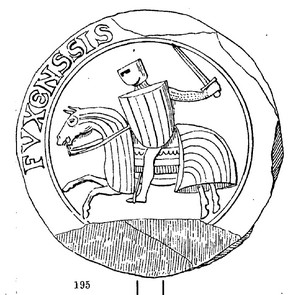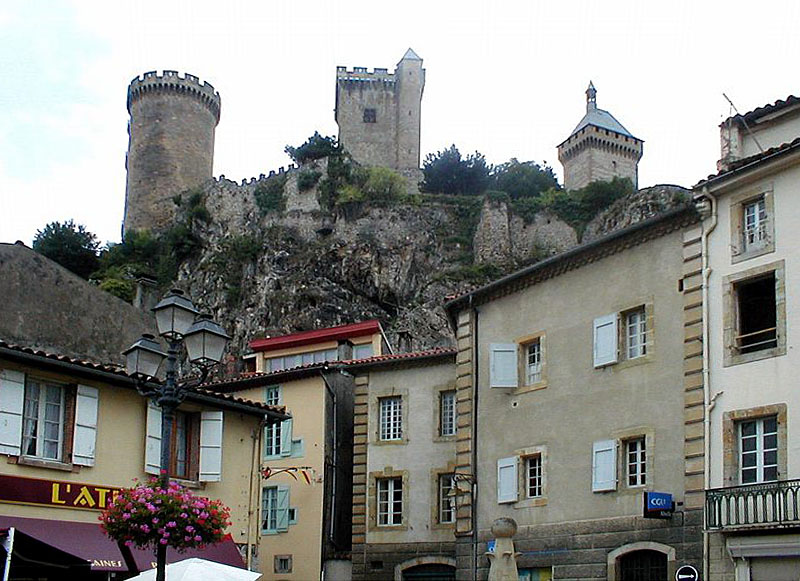|
Roger IV Of Foix
Roger IV (died 24 February 1265), son and successor of Roger-Bernard II the Great, was the eighth count of Foix from 1241 to his death. His reign began with the south again at war with the north in France and, though he was reluctant to join his father's old ally, Raymond VII of Toulouse, in revolt and he did not aid the king of England, Henry III, in his Saintonge War. Roger IV was a vassal of both the count of Toulouse (for his county of Foix) and the king of France (for his Carcassonne lands), then Louis IX. His loyalty to the king, however, took precedence and war broke out with Raymond VII (October 1242). Although Raymond was forced to submit to the king on 30 November, the war with Roger continued until January 1243, when the king ended it. The count of Foix was now solely a vassal of the king and Raymond spent the rest of his life (until 1249) trying to retrieve Roger's homage, to no avail. Like his father, Roger IV had troubles with the church and the bishop of Urgel ... [...More Info...] [...Related Items...] OR: [Wikipedia] [Google] [Baidu] |
Roger-Bernard II Of Foix
Roger Bernard II (c. 1195 – 26 May 1241), called the Great, was the seventh count of Foix from 1223 until his death. He was the son and successor of the count Raymond-Roger and his wife Philippa of Montcada. Albigensian crusade He made his name famous in 1217 when, for six weeks, he defended the castle of Montgrenier against the onslaught of Simon de Montfort, 5th Earl of Leicester. That same year, he distinguished himself at the siege of Toulouse. In 1220, he assisted his father in the recapture of Lavaur and Puylaurens and was instrumental in helping his father retake his lost dominions. The resumption of Mirepoix wasn't accomplished until his own reign, however. At the moment of his accession, he and the new count of Toulouse, Raymond VII, besieged Carcassonne. On 14 September 1224, the Albigensian Crusaders surrendered and the war came to an end, each southern lord making peace with the church. However, in 1226, the new king of France, Louis VIII, called ''the L ... [...More Info...] [...Related Items...] OR: [Wikipedia] [Google] [Baidu] |
House Of Foix
Foix (; oc, Fois ; ca, Foix ) is a commune, the former capital of the County of Foix. It is the capital of the department of Ariège as it is the seat of the Préfecture of that department. Foix is located in the Occitanie region of southwestern France. It is the second least populous French departmental capital, the least populous being Privas. Foix lies south of Toulouse, close to the borders with Spain and Andorra. As of 2019, the city had a population of 9,493. It is only the second biggest town in Ariège, the biggest being Pamiers, which is one of the two sub-prefectures, the other being St Girons. Foix is twinned with the English cathedral city of Ripon, with the Spanish towns of Sarroca de Lleida and Lerida and the Andorran capital Andorre-la-Vieille. History The Romans built a fort on the steep rock from which Foix castle now dominates the town. The town of Foix probably owes its origin to an oratory founded by Charlemagne, which afterwards became the Abbey of S ... [...More Info...] [...Related Items...] OR: [Wikipedia] [Google] [Baidu] |
1265 Deaths
1 (one, unit, unity) is a number representing a single or the only entity. 1 is also a numerical digit and represents a single unit of counting or measurement. For example, a line segment of ''unit length'' is a line segment of length 1. In conventions of sign where zero is considered neither positive nor negative, 1 is the first and smallest positive integer. It is also sometimes considered the first of the infinite sequence of natural numbers, followed by 2, although by other definitions 1 is the second natural number, following 0. The fundamental mathematical property of 1 is to be a multiplicative identity, meaning that any number multiplied by 1 equals the same number. Most if not all properties of 1 can be deduced from this. In advanced mathematics, a multiplicative identity is often denoted 1, even if it is not a number. 1 is by convention not considered a prime number; this was not universally accepted until the mid-20th century. Additionally, 1 is the s ... [...More Info...] [...Related Items...] OR: [Wikipedia] [Google] [Baidu] |
Count Of Foix
The Count of Foix ruled the independent County of Foix, in what is now Southern France, during the Middle Ages. The House of Foix eventually extended its power across the Pyrenees mountain range, joining the House of Bearn and moving their court to Pau in Béarn. The Count Francis Phoebus became King of Navarre in 1479. The last count unified with King Henry IV of France in 1607. To this day, the President of France is considered an unofficial successor of the Count (as the current ruler of the French state) as Co-Prince of Andorra. Gallery of Arms File:Arms of the Counts of Foix.svg File:Arms of Foix-Béarn.svg, Arms of the House of Foix-Béarn File:Arms of Foix-Grailly.svg, Arms of the House of Foix-Grailly File:Royal Lesser Arms of Navarre (1479-1483).svg, Arms of the House of Foix-Grailly-Navarre File:Royal Arms of Navarre (1483-1512).svg, Arms of the House of Albret File:Arms of Henri de Bourbon.svg, Arms of the House of Bourbon List of counts of Foix House of Foix ... [...More Info...] [...Related Items...] OR: [Wikipedia] [Google] [Baidu] |
James II Of Majorca
James II ( ca, Jaume) (31 May 1243 – 29 May 1311) was King of Majorca and Lord of Montpellier from 1276 until his death. He was the second son of James I of Aragon and his wife, Violant, daughter of Andrew II of Hungary. In 1279, by the Treaty of Perpignan, he became a vassal of the Crown of Aragon. Biography James inherited from his father a realm including three of the Balearic Islands (Majorca, Ibiza, and Formentera), the counties of Roussillon and Cerdanya, the dominion of Montpellier, the barony of Aumelàs, and the viscounty of Carladès. He also gained tribute from the fourth Balearic island, Menorca, which remained under Muslim control throughout his life. He ruled as a vassal of his brother Peter III of Aragon, a subordinate status which he sought to escape. In 1276, his former seneschal, Ramon Llull persuaded James to fund a language school for Franciscan missionaries at Miramar. France and Aragon contested for control of Sicily. James held rights over borderla ... [...More Info...] [...Related Items...] OR: [Wikipedia] [Google] [Baidu] |
Esclaramunda Of Foix
Esclaramunda of Foix (1250–1315) was Queen consort of Majorca from 1276-1311. Life She was the daughter of Roger IV of Foix and Brunissenda of Cardona, daughter of Ramon VIII, Viscount of Cardona. Named after her great-grandmother, Esclaramunda was twenty years old when she married James II of Majorca. She was responsible for tutoring her grandson James III of Majorca. She was protector of the Order of Mercy. Her feast is on 22 October. Marriage and issue In 1275, Esclaramunda married James II of Majorca, with whom she had six children: * James, who became a Franciscan friar before his father's death. * Sancho, James II's successor * Sancha of Majorca, who married Robert of Naples. * Ferdinand, father of James III * Philip, regent of Majorca during James III's minority * Elizabeth, wife of Juan Manuel, Prince of Villena Don Juan Manuel (5 May 128213 June 1348) was a Spanish medieval writer, nephew of Alfonso X of Castile, son of Manuel of Castile and Beatrice of ... [...More Info...] [...Related Items...] OR: [Wikipedia] [Google] [Baidu] |
Aimery IV, Viscount Of Narbonne
Aimeric or Aymeric or Aimery (from '' Haimirich'' or ''Amalric'') is a male given name: * Aimeric de Belenoi (fl. 1215–1242), troubadour * Prince Aymeric of Belgium (born 2005) * Aymeric Jaubert de Barrault (died 1613), mayor of Bordeaux. * Aymeric Jett Montaz (born 2004), French-Canadian actor * Aymeric Laporte (born 1994), French footballer who plays for Manchester City F.C. * Aimery of Limoges * Aimerico Manrique de Lara, Aimeric or Aymeric, sometimes Gallicised as Aimery * Aymeri de Narbonne, legendary hero of France * Aimery II of Narbonne (d. 1134), Viscount of Narbonne * Aimery III of Narbonne (d. 1239), known in Spanish as Aimerico Pérez de Lara, Viscount of Narbonne * Aimery IV of Narbonne (Amerigo di Narbona) (c. 1230 – 1298), Viscount of Narbonne, an Italian condottiero * Ademar de Peiteus (Aimeric de Peiteus) * Adémar II de Poitiers Adémar II de Poitiers, known in Old Occitan as Ademar or Aimeric de Peiteus, was the count of Valentinois and ''de facto'' ruler ... [...More Info...] [...Related Items...] OR: [Wikipedia] [Google] [Baidu] |
Roger-Bernard III Of Foix
Roger-Bernard III (1243 – 3 March 1302) was the Count of Foix from 1265 to his death. He was the son of Roger IV of Foix and Brunissende of Cardona. He entered into conflicts with both Philip III of France and Peter III of Aragon, who held him in captivity for a time. He was nevertheless a distinguished poet and troubadour. Conflict with Philip III His conflict with Philip III was rooted in the longstanding desire of the French monarchy to establish its authority in Languedoc, where, since the 10th century, it had been practically a dead letter. In 1272, Roger-Bernard allied with Gerald VI, Count of Armagnac to attack the lord of Sompuy, who, however, applied for protection to the king. This brought the king and the count into direct opposition. Ignoring the royal command, the two counts went to war. Philip, claiming rights as the heir of his uncle Alfonso of Poitou, invaded Languedoc at the head of a large army. Roger-Bernard fled to his castle at Foix and the Seneschal o ... [...More Info...] [...Related Items...] OR: [Wikipedia] [Google] [Baidu] |



